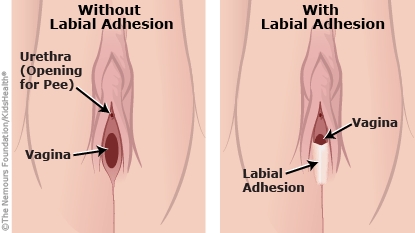Labial Adhesions: How to Care for Your Child
Labial adhesions are common in young girls. They usually go away on their own but may require treatment with a prescription cream.


The labia minora are the two skin-like flaps that surround the openings to the vagina and urethra (the tube that carries pee from the bladder to the outside of the body). In infants and girls who haven't gone through puberty, the labia are very delicate and prone to irritation. Sometimes they stick together as they grow new cells to heal from irritation. This is called labial adhesions and it can look like a thin white line along the labial opening. Sometimes, the adhesions cover the urethral and vaginal openings. As a result, a girl may have discomfort, urinary tract or vaginal infections, or problems peeing.
Most adhesions eventually separate on their own. If the adhesions are causing problems, your health care provider may prescribe an estrogen or steroid cream to be applied to the area. Rarely, the adhesions prevent a girl from peeing and surgery may be needed.

-
Use prescribed medicines as directed.
-
Once the adhesions have parted, it's important to keep the area clean and to apply white petroleum jelly to the area twice a day for 6–12 months. This keeps the labia from growing back together.
-
To prevent irritation to the labia:
-
In infants, change diapers frequently and wipe from front to back.
-
Teach toilet-trained girls to wipe from front to back after using the toilet.
-
Your daughter should take daily baths in plain warm water. Do not add soap, bubble bath, or scented products to the bathwater.
-
Undergarments for toilet-trained girls should be white cotton. Wash undergarments in unscented, dye-free detergent.
-
Schedule a follow-up appointment as recommended by your health care provider.

-
Your daughter has pain when peeing.
-
The labia don't separate as expected.
-
You notice increased irritation or discharge in your child's vaginal area.
-
You have any questions.
